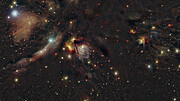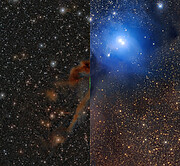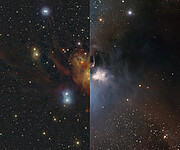Komunikat prasowy
Teleskopy ESO pokazują ukryte widoki olbrzymich gwiezdnych żłobków
11 maja 2023
Przy pomocy Visible and Infrared Survey Telescope for Astronomy (VISTA) astronomowie utworzyli wielki atlas w podczerwieni dla pięciu pobliskich gwiezdnych żłobków, łącząc razem ponad milion zdjęć. Te wielkie mozaiki zdjęć ukazują młode gwiazdy w trakcie ich powstawania, osadzone w grubych obłokach pyłu. Dzięki wspomnianym obserwacjom, astronomowie mają unikalne narzędzie do rozszyfrowania skomplikowanej zagadki gwiezdnych narodzin.
„Na tych zdjęciach możemy wykryć nawet najsłabsze źródła światła, takie jak gwiazdy znacznie mniej masywne niż Słońce, ujawniając obiekty, których nikt nigdy wcześniej nie widział” mówi Stefan Meingast, astronom z Uniwersytetu Wiedeńskiego w Austrii, pierwszy nowych opublikowanych dzisiaj w „Astronomy & Astrophysics”. „Pozwoli nam to zrozumieć procesy transformacji gazu i pyłu w gwiazdy.”
Gwiazdy tworzą się, gdy obłoki gazu i pyłu zapadają się pod wpływem własnej grawitacji. Jednak szczegóły, jak to się dzieje, nie są w pełni zrozumiane. Ile gwiazd rodzi się z obłoku? Jak masywne są? Ile gwiazd będzie miało także planety?
Aby odpowiedzieć na te pytania, zespół Meingasta dokonał przeglądu pięciu pobliskich obszarów gwiazdotwórczych, korzystając z teleskopu VISTA w Obserwatorium Paranal w Chile. Przy pomocy kamery podczerwonej VIRCAM na teleskopie VISTA, grupa badawcza zarejestrowała światło pochodzące z głębokiego wnętrza obłoku pyłu. „Pył przesłania młode gwiazdy, czyniąc je wirtualnie niewidocznymi dla naszych oczu. Jedynie fale podczerwone pozwalają na zajrzenie głębiej w takie obłoki, aby badać gwiazdy w trakcie ich powstawania” wyjaśnia Alena Rottensteiner, doktorantka na Uniwersytecie Wiedeńskim, współautorka badań.
Przegląd, który nazwano VISIONS, obserwował rejony gwiazdotwórcze w gwiazdozbiorach Oriona, Wężownika, Kameleona, Korony Południowej i Wilka. Rejony te znajdują się mniej niż 1500 lat świetlnych od nas są tak duże, że rozciągają się na olbrzymim obszarze nieba. Średnica pola widzenia VIRCAM ma szerokość trzech tarcz Księżyca w pełni, co czyni go unikatowym zestawem do wykonywania map tych niezwykle dużych obszarów.
Zespół badawczy uzyskał ponad milion zdjęć w okresie pięciu lat. Poszczególne zdjęcia zostały połączone razem w wielkie mozaiki, które teraz opublikowano, ukazując gigantyczne kosmiczne krajobrazy. Szczegółowe panoramy pokazują ciemne pasma pyłu, świecące obłoki, nowo narodzone gwiazdy i odległe gwiazdy tła z Drogi Mlecznej.
Ponieważ dane obszary były obserwowane wielokrotnie, dane VISIONS pozwolą astronomom na zbadanie, jak poruszają się młode gwiazdy. „Dzięki VISIONS monitorujemy niemowlęce gwiazdy przez kilka lat, co pozwoli nam na zmierzenie ich ruchu i dowiedzenie się, w jaki sposób opuszczają swoje rodzime obłoki” wyjaśnia João Alves, astronom z Uniwersytetu Wiedeńskiego, kierownik naukowy VISIONS. Nie jest to przesunięcie tych gwiazd widziane z Ziemi jest tak małe, jak grubość ludzkiego włosa widziana z dystansu 10 kilometrów. Pomiary ruchów gwiazd uzupełnią te uzyskane przy pomocy misji Gaia, prowadzonej przez Europejską Agencję Kosmiczną. Dane z misji Gaia są z zakres uwidzialnego, w którym młode gwiazdy są ukryte za grubymi zasłonami pyłu.
Atlas VISIONS da astronomom wiele pracy na kolejne lata. „Jest tutaj ogromna, długotrwała wartość dla społeczności astronomicznej, dlatego ESO prowadzi publiczne przeglądy, takie jak VISIONS,” mówi Monika Petr-Gotzens, astronom z ESO w Garching (Niemcy), współautorka badań. Co więcej, VISIONS położy podwaliny pod przyszłe obserwacje przy pomocy teleskopów takich, jak Ekstremalnie Wielki Teleskop (ELT), budowany obecnie przez ESO w Chile, z planet rozpoczęcia działania jeszcze w tej dekadzie. „ELT pozwoli na powiększenie konkretnych rejonów z niebywałymi szczegółami, dając nam nie widziane dotąd zbliżenie na pojedyncze gwiazdy, które obecnie się tam tworzą” podsumowuje Meingast.
Więcej informacji
Wyniki badań zaprezentowano w artykule pt. „VISIONS: The VISTA Star Formation Atlas”, który ukaże się w Astronomy & Astrophysics (doi: 10.1051/0004-6361/202245771)
Skład zespołu badawczego: Stefan Meingast (University of Vienna, Austria [Wiedeń]), João Alves (Wiedeń), Hervé Bouy (Université de Bordeaux, Francja [Bordeaux]), Monika G. Petr-Gotzens (European Southern Observatory, Niemcy [ESO]), Verena Fürnkranz (Max-Planck-Institut für Astronomie, Niemcy [MPIA]]), Josefa E. Großschedl (Wiedeń), David Hernandez (Wiedeń), Alena Rottensteiner (Wiedeń), Joana Ascenso (Universidade do Porto, Portugalia [Porto]; Universidade de Lisboa, Portugalia [Lizbona]), Amelia Bayo (ESO; Universidad de Valparaíso, Chile), Erik Brändli (Wiedeń), Anthony G. A. Brown (Leiden University, Holandia), Jan Forbrich (University of Hertfordshire, Wielka Brytania [Hertfordshire]), Alyssa Goodman (Harvard-Smithsonian Center for Astrophysics, USA [CfA]), Alvaro Hacar (Wiedeń), Birgit Hasenberger (Wiedeń), Rainer Köhler (The CHARA Array of Georgia State University, USA), Karolina Kubiak (Lizbona), Michael Kuhn (Hertfordshire), Charles Lada (CfA), Kieran Leschinski (Wiedeń), Marco Lombardi (Università degli Studi di Milano, Italy), Diego Mardones (Universidad de Chile, Chile), Núria Miret-Roig (European Space Agency, European Space Research and Technology Centre, Netherlands [ESA]), André Moitinho (Lizbona), Koraljka Mužiiić (Porto; Lizbona), Martin Piecka (Vienna), Laura Posch (Wiedeń), Timo Prusti (ESA), Karla Peña Ramírez (Universidad de Antofagasta, Chile), Ronny Ramlau (Johannes Kepler University Linz, Austria; Johann Radon Institute for Computational and Applied Mathematics, Austria), Sebastian Ratzenböck (Wiedeń; Research Network Data Science at Uni Vienna), Germano Sacco (INAF – Osservatorio Astrofisico di Arcetri, Włochy), Cameren Swiggum (Wiedeń), Paula Stella Teixeira (University of St Andrews, Wielka Brytania), Vanessa Urban (Wiedeń), Eleonora Zari (MPIA) oraz Catherine Zucker (Bordeaux).
Europejskie Obserwatorium Południowe (ESO) umożliwia naukowcom z całego świata na odkrywanie tajemnic Wszechświata z korzyścią dla nas wszystkich. Projektujemy, budujemy i zarządzamy światowej klasy obserwatoriami naziemnymi – których astronomowie używają do odpowiadania na ciekawe pytania i szerzenia fascynacji astronomią – a także promujemy międzynarodową współpracę w astronomii. Ustanowione w 1962 roku jako organizacja międzynarodowa, ESO jest wspierane przez 16 krajów członkowskich (Austria, Belgia, Czechy, Dania, Finlandia, Francja, Hiszpania, Irlandia, Holandia, Niemcy, Polska, Portugalia, Szwajcaria, Szwecja, Wielka Brytania oraz Włochy), a także Chile jako kraj gospodarz, oraz Australię jako strategicznego partnera. Siedziba ESO, a także jego centrum popularyzacji nauki i planetarium (ESO Supernova) znajdują się w pobliżu Monachium w Niemczech, natomiast chilijska pustynia Atakama – niesamowite miejsce z wyjątkowymi warunkami do obserwacji nieba – jest domem dla naszych teleskopów. ESO zarządza trzema lokalizacjami obserwacyjnymi w Chile: La Silla, Paranal i Chajnantor. W Paranal ESO posiada teleskop VLT (Very Large Telescope – Bardzo Duży Teleskop) oraz dwa teleskopy do przeglądów nieba. VISTA pracuje w podczerwieni, VLT Survey Telescope w zakresie widzialnym. W Paranal ESO zarządza także południowym obserwatorium CTA (Cherenkov Telescope Array South) – największym na świecie i najbardziej czułym obserwatorium promieniowania gamma. Wspólnie z międzynarodowymi partnerami ESO zarządza także radioteleskopami APEX i ALMA, które są instrumentami do obserwacji nieba w zakresach milimetrowym i submilimetrowym. Na Cerro Armazones, niedaleko Paranal, budujemy „największe oko świata na niebo”, czyli Ekstremalnie Wielki Teleskop (Extremely Large Telescope, ELT). Nasza działalność w Chile jest zarządzania z biur ESO w Santiago, gdzie współpracujemy też z chilijskimi partnerami.
Linki
- Research paper
- Photos of VISTA
- For journalists: subscribe to receive our releases under embargo in your language
- For scientists: got a story? Pitch your research
Kontakt
Stefan Meingast
University of Vienna
Vienna, Austria
E-mail: stefan.meingast@univie.ac.at
Juan Carlos Muñoz Mateos
ESO Media Officer
Garching bei München, Germany
Tel.: +49 89 3200 6176
E-mail: press@eso.org
Krzysztof Czart (Kontakt dla mediów Polska)
Sieć Popularyzacji Nauki ESO
oraz Urania - Postępy Astronomii
Toruń, Polska
Tel.: +48 513 733 282
E-mail: eson-poland@eso.org
O komunikacie
| Komunikat nr: | eso2307pl |
| Typ: | Milky Way : Nebula : Type : Star Formation |
| Facility: | Visible and Infrared Survey Telescope for Astronomy |
| Instrumenty: | VIRCAM |
| Science data: | 2023A&A...673A..58M |
Po angielsku














